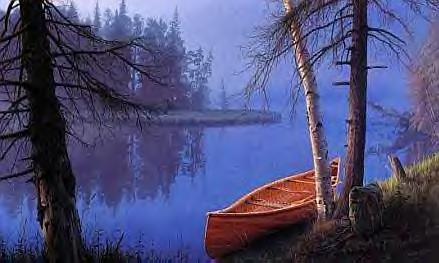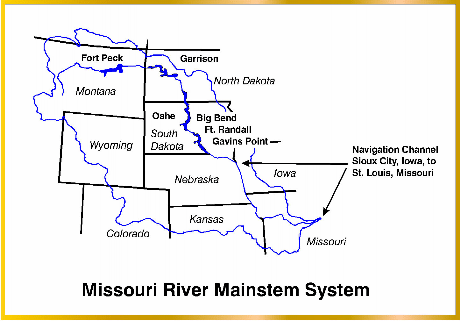|
|
Canku Ota |
|
|
(Many Paths) |
||
|
An Online Newsletter Celebrating Native America |
||
|
June 16, 2001 - Issue 38 |
||
|
|
||
|
Rivers Run Through It |
||
|
by Doreen Yellow Bird Grand Forks Herald |
 I
am fascinated by rivers. They seem to have their own personalities -- their own spirits. Perhaps my fascination
comes from deep inside -- something I inherited from an ancestor -- a grandmother who lived near the Missouri or
Platte river. I
am fascinated by rivers. They seem to have their own personalities -- their own spirits. Perhaps my fascination
comes from deep inside -- something I inherited from an ancestor -- a grandmother who lived near the Missouri or
Platte river. On my trip down the center of the Plains a few weeks ago, I was captivated by the different rivers I passed over, around and beside. All the rivers and streams seemed drawn to the mother of rivers -- the Mississippi -- but they first must merge with the Missouri. And, so they wind and wiggle East. I crossed the Missouri River at Sioux City, Iowa. It's awesome, and I stared. The river is dotted with sand islands. The sandy color and the elongated patterns of the dunes and water look like the pelt of African lion. And like the lion, there was something about the power of this river that made me draw a deep breath. I drove alongside her for several miles before the road and river parted ways. I was in Iowa now. As I settled in for that two- or three-hour drive to Council Bluff, Iowa, I couldn't help but think about something I read in the journal of an explorer about the rivers. Many tribal nations lived along these waterways. The shorelines were good sources of wood for shelters and fires, and the rivers offered both transportation and food. Those tribes living along the waterways seemed to have little fear of the water, and most were excellent swimmers, fishermen and skilled boaters. But, these were skills they had to learn. In one of the journals, the explorer tells of throwing young Native children into the Missouri, thinking the children knew instinctively how to swim -- like a dog, I guess. Most animals will swim if they are thrown in the water. The children drowned, which seemed to surprise the explorer. I learned to swim because my brother had something of the same idea as these explorers, only he knew I could get around in the water and swim a little. I should say, in his defense, he was there to catch me if I didn't swim, too. He wanted to teach me "how not to panic in the river," he said -- not a good way, I might add. I must also say he had some good traits, and sometimes I miss him. He died some 10 years ago. One of the rivers that usually brings a smile and good thoughts is the Little Sioux River in Iowa. I think about my great-grandfather, Little Sioux, when I pass it. The river is not named for my great-grandfather. Most likely it is named because it is not the Big Sioux River that runs through South Dakota. Even so, there is a pride seeing the name proudly displayed beside this river, with its high dikes and gently flowing water. I drove several hundred miles inland, then turned south. Some of the rivers cut deep into the land, while others just seemed to curl around trees in their paths. The land in this part of the Plains is mostly crops. It has been cleared. It is obvious where the rivers are, because the trees seem to crowd around them. From a distance, the trees look like thick, tall broccoli. When my long trip ended, I felt a renewed kinship with our Red River -- the contrary one that seems to run backwards. It has the same spirit as those big rivers and in spite of the problems, it is good living beside it. The oral stories of our people tell us that rivers were the life-blood of the land and people. Crossing and crisscrossing these rivers awaken an ancestral relationship with these spirits and renewed in me an awe for them. |
|
The map below shows the path of the Missouri River |
|
|
|
|
||
|
|
||
| Canku Ota is a free Newsletter celebrating Native America, its traditions and accomplishments . We do not provide subscriber or visitor names to anyone. Some articles presented in Canku Ota may contain copyright material. We have received appropriate permissions for republishing any articles. Material appearing here is distributed without profit or monetary gain to those who have expressed an interest. This is in accordance with Title 17 U.S.C. section 107. | ||
|
Canku Ota is a copyright © 2000, 2001 of Vicki Lockard and Paul Barry. |
||
|
|
|
|
|
The "Canku Ota - A Newsletter Celebrating Native America" web site and its design is the |
||
|
Copyright © 1999, 2000, 2001 of Paul C. Barry. |
||
|
All Rights Reserved. |

